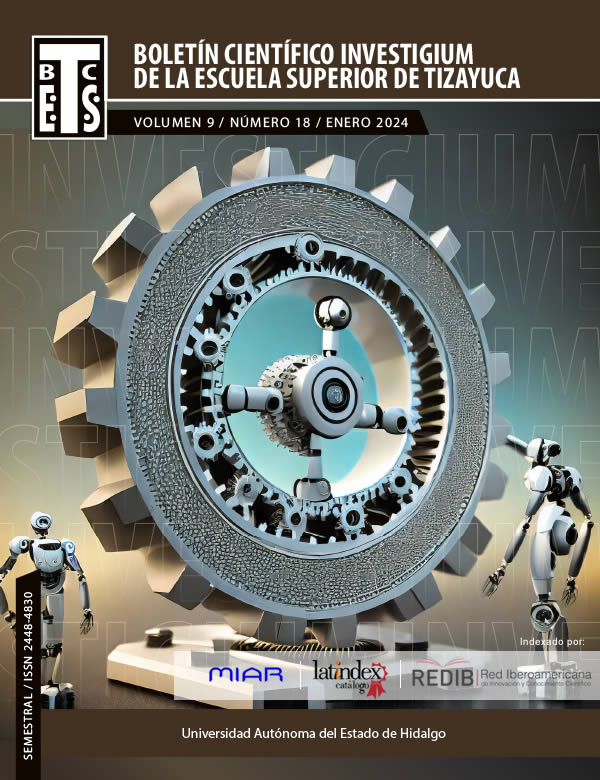Emotional Intelligence in teachers and Academic Performance in students of a public secondary in Pachuca, Hidalgo
Abstract
The present investigation arises from the concern to know what is the influence of the emotions of the teachers when teaching classes and what impact it has within the educational area of the students. For this reason, Emotional Intelligence (EI) and Academic Performance (AR) were measured in a public secondary school in Pachuca de Soto, Hidalgo, from a quantitative perspective. For Goleman (1995) EI is the ability to recognize our own feelings and those of others, to motivate ourselves and to adequately manage social relationships, on the other hand AR (Navarro, 2003) is sometimes called school aptitude, performance academic or school performance, since generally, in the texts, school life and teaching experience are used as synonyms. González (1988) defines school performance as the acquisition of a set of values, attitudes, behaviors and knowledge indicated as desirable for society and educational canters.
The population that participated is composed of 172 students and 21 teachers, from a public high school in Pachuca de Soto, Hidalgo, who were chosen in a simple random way. This study is quantitative in a correlational field. It has a non-experimental cross-sectional design for the collection of data in the case of teachers, the Emotional Intelligence Trait Meta-Mood Scale (TMMS-24) (Fernández and Berrocal, 2004) and in the case of students, report cards were collected.
Downloads
References
Boring, G.E. (1950). A History of Experimental Psychology. New York: Appleton, Century-Crofts.
Bricklin, B. & Bricklin, M. (1988). Causas psicológicas del bajo rendimiento escolar. México: Pax-México
Galton, F. (1962). Inquiries into Human Faculty and its Development (pp. 482-488). New York: E. P. Dutton. (Trabajo original publicado en 1907).
Gardner, H. (1993a). The Quest for Mind: Piaget, Lévi Strauss, and the Structuralist Movement. Chicago: University Chicago Press.
Glasser, W. (1985). Escuelas sin fracasos. México: Pax-México
Goleman, D. (1995a). Emotional intelligence. New York: Bantam.
LeDouxJ.E.(1987).Emotion.InPlum,F.(ed.),HandbookofPhysiology.1:TheNervousSystem,VolV, Higher Functions of the Brain, American Physiological Society. Bethesda, pp. 419–460.
Maclure, S.; Davies, P. (1994). Aprender a pensar, pensar en aprender. Barcelona: Gedisa
Markova, D. y Powell, A. (1997). Cómo desarrollar la inteligencia de sus hijos. México: Selector.
Morales & Quiñones (2007). El efecto de la impulsividad sobre la agresividad y sus consecuencias en el rendimiento de los adolescentes (Tesis Doctoral). Universitat Rovira i Virgili.
Navarro, R. (2003) El rendimiento académico: concepto, investigación y desarrollo REICE. Revista Iberoamericana sobre Calidad, Eficacia y Cambio en Educación, vol. 1, núm. 2, julio-diciembre, 2003, p.3.
Ribot, Th. (1925). La lógica de los sentimientos. Madrid: Daniel Jorro Editor. (Trabajo original publicado en 1905).
Salovey, P., Mayer, J.D., Goldman, S.L., Turvey, C. y Palfai, T.P. (1995). Emotional attention, clarity and repair: exploring emotional intelligence using the trait meta-mood scale. En J. Pennebaker (ed.): Emotion, disclousure and health. Washington, D.C.: American Psychological Association
Thorndike, L.L. (1920). Intelligence and its uses. Harper’s Magazine, 140, 227-235
Trujillo& Rivas (2005), Evolución y modelos de inteligencia emocional INNOVAR. Revista de Ciencias Administrativas y Sociales, vol. 15, núm. 25, Universidad Nacional de Colombia Bogotá, Colombia.
Vygostsky, L. (1978). Mind in Society. In: M. Cole (comp.). Cambridge: Harvard University Press
Copyright (c) 2024 Maria Isabel Roque Hernández, Francisco Omar Peña Guajardo

This work is licensed under a Creative Commons Attribution-NonCommercial-NoDerivatives 4.0 International License.











